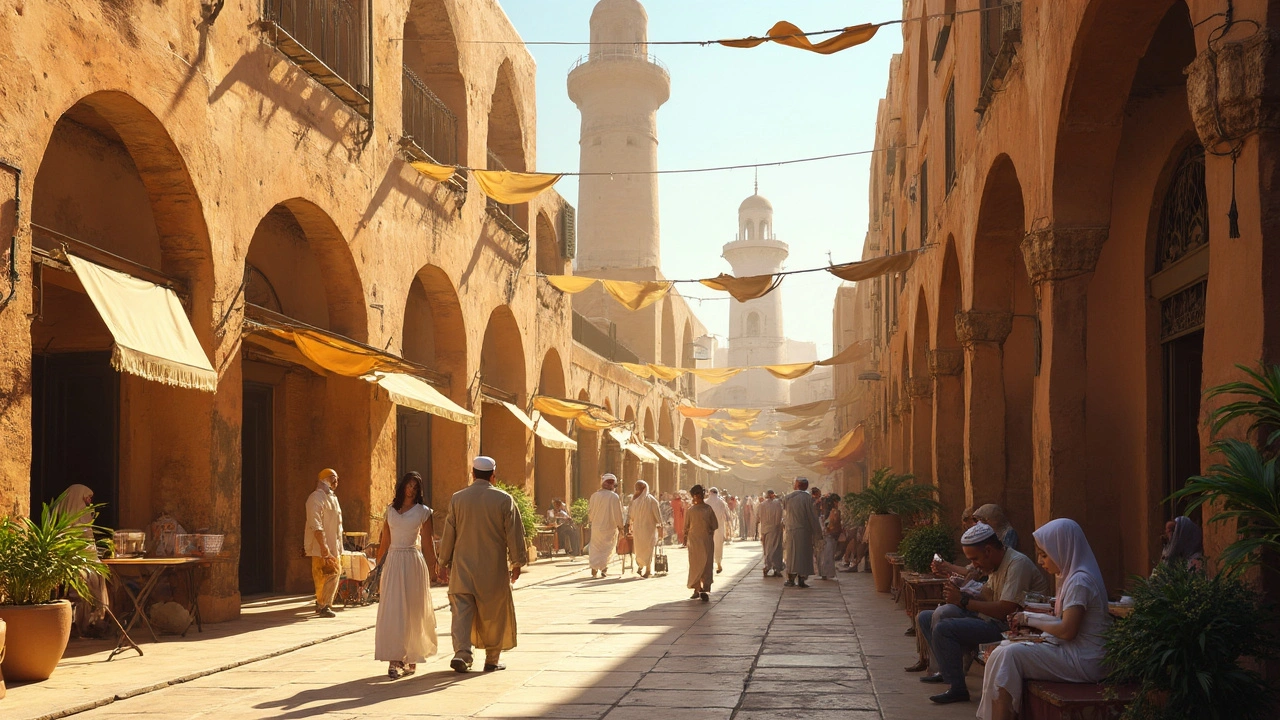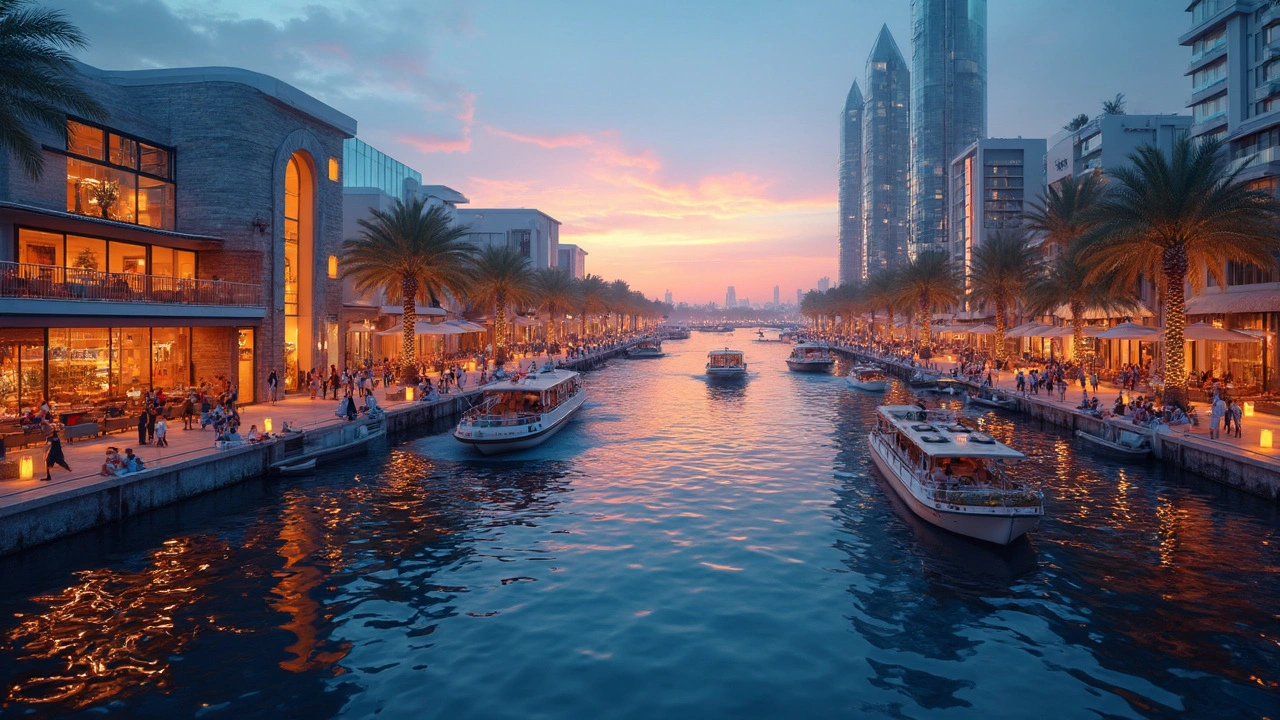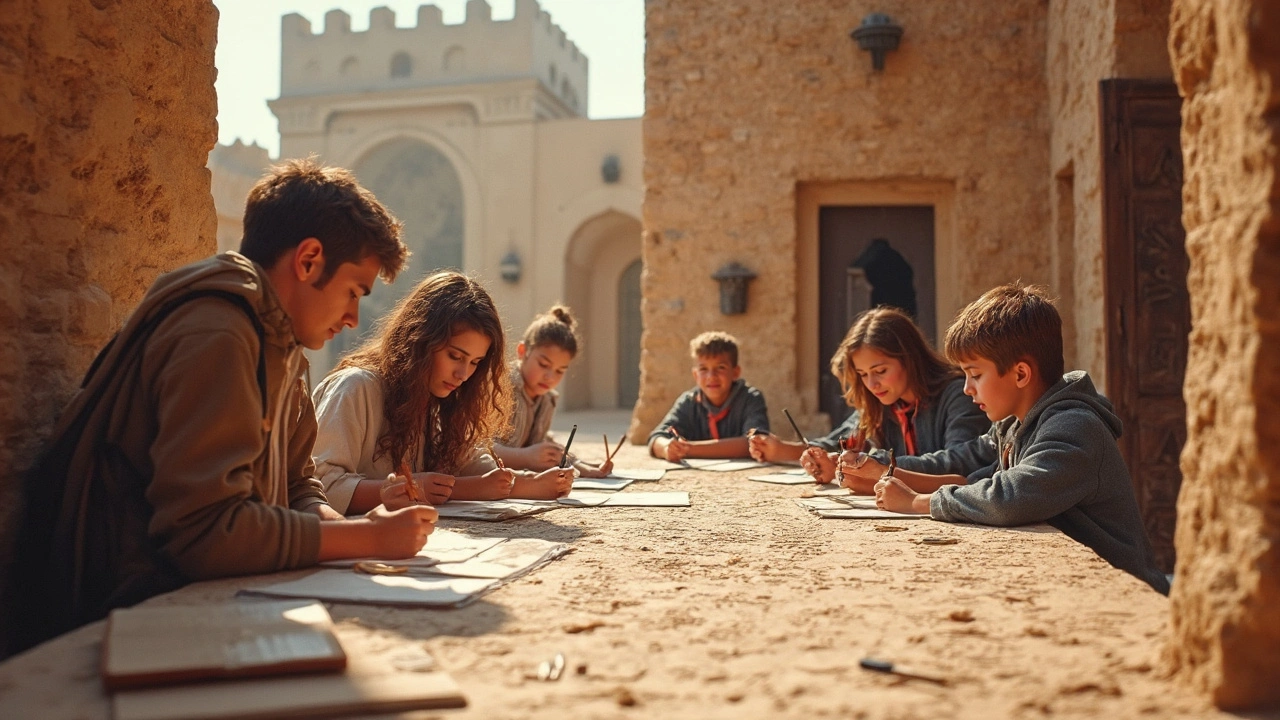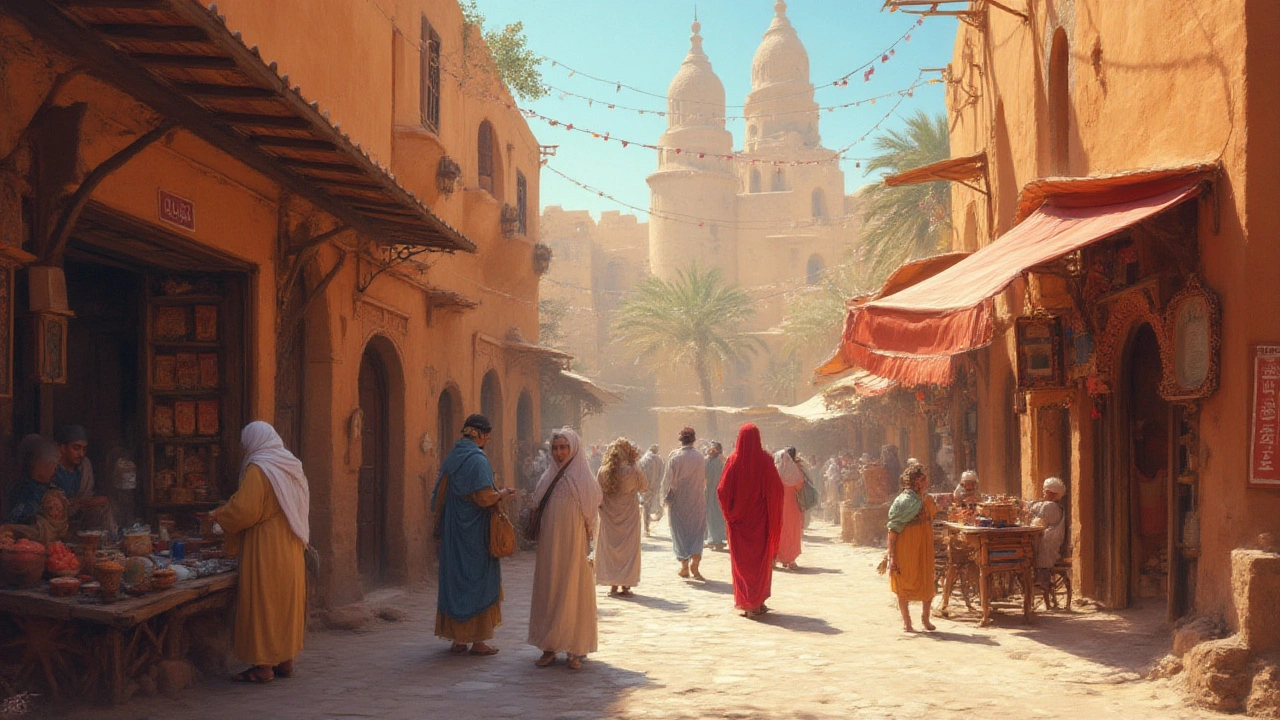Dubai's Architectural Marvels: Exploring Historical Sites Up Close

People think Dubai only means futuristic buildings and luxury malls, but the city has more hidden layers than you might expect. Walk through the streets of Al Fahidi Historical Neighbourhood—right by Dubai Creek—and it feels like stepping back a hundred years. Go early in the morning, before the sun cranks up, for a quiet stroll through stone alleys, wind towers, and cozy courtyards. You’ll see old houses built way before the Burj Khalifa even existed, showing how folks beat the heat with smart design.
If you’re new in town or a longtime resident, start with Al Seef. It’s a clever blend of old and new, with souks selling everything from handmade crafts to modern coffee. Try grabbing karak chai from a local stall—don’t worry, you can skip the chain cafes for now. Locals and tourists hang out along the waterfront because it’s chill, and you get proper views of dhow boats drifting along the creek. Getting there is easy: just hop on the Dubai Metro to Al Fahidi or BurJuman station, then walk about ten minutes.
- Old Dubai’s Timeless Landmarks
- Hidden Architectural Gems in the City
- How Tradition Meets Innovation
- Planning Your Historical Adventure
Old Dubai’s Timeless Landmarks
Forget about the shiny towers for a minute—Dubai historical sites are where you see the real roots of the city. The Al Fahidi Historical Neighbourhood, also called Bastakiya, is probably where you want to start if you care about the old Dubai vibe. Built around the late 1800s, it’s packed with traditional wind-tower houses. These towers weren’t just for show—they acted like old-school air conditioners, funneling cool air into homes long before anyone saw an AC unit.
Drop by the Dubai Museum located in Al Fahidi Fort. This place is older than most people think—the fort itself dates back to 1787, making it the oldest standing building in Dubai. Inside, you’ll catch a real sense of what life was like back when Dubai was all about fishing, trading, and pearling. The museum doesn’t take long, but it fills in the backstory you need before you move on to the waterfront or the markets.
Here’s a quick look at visitor stats and details that might help you plan:
| Landmark | Open Since | Average Visitors/Day | Notable Feature |
|---|---|---|---|
| Al Fahidi Fort (Dubai Museum) | 1787 / 1971 as museum | 1100 | Oldest building in Dubai |
| Grand Souk Deira | Early 1900s | 1500 | Gold, spices, and textiles market |
| Al Seef Area | 2017 (heritage district inspired by Old Dubai) | 2000 | Modern-heritage blend |
Don’t skip the Grand Souk Deira. Go in the late afternoon to escape the midday heat. Locals come for gold, spices, and everything needed for a good biryani. Bargaining is normal here, so don’t be shy about haggling over prices—just keep it polite and light-hearted. Most stalls take cash, but more are accepting cards these days.
For families, the Sheikh Saeed Al Maktoum House is another solid pick. This was home to Dubai’s ruling family until 1958. Today, it’s sort of a mini-museum on the Dubai Creek side, packed with old photos, coins, and documents. Kids actually get a kick out of the building’s maze-like rooms and views over the water. If you’re visiting during winter, there are often open-air events and heritage nights—worth checking UAE event listings for up-to-date details.
- Wear light, respectful clothing—especially if you plan to visit mosques nearby.
- Start early to beat Dubai’s heat and crowds.
- Public transport, like the RTA water taxi (abra), is cheap and the easiest way to jump between the creek’s banks.
A quick tip for Instagram fans: best light for photos is just after sunrise or around sunset. That’s when the colors really pop and the crowds haven’t taken over yet.
Hidden Architectural Gems in the City
Most people head straight for Dubai’s biggest names, but there are plenty of places that even longtime residents haven’t checked out. Tucked away in Deira, you’ll find the Heritage House—an old merchant’s home from the late 1800s. It’s been fixed up but still shows off coral and gypsum walls and a peaceful central courtyard. The entry’s free, and it’s great for snapping photos that actually tell a story about Dubai’s past and not just its shiny present.
Another worth-it spot is the Jumeirah Archaeological Site. It doesn’t grab headlines, but this part of Jumeirah has real remains of an ancient settlement dating back to the Abbasid period, about the 9th to 11th century. You probably won’t stumble on this while driving around, so set your maps—there’s a small visitor center, and the area feels completely different from the busy blocks nearby. Quick heads up: check opening hours before you go. Sometimes, it’s for groups and school kids, but you can call ahead to tag along with a guided walk.
The old Al Ahmadiya School in Deira shouldn’t be missed if you’re into local history. Open since 1912, it was Dubai’s first formal school and it doubled as a community hub. Today, it’s a museum filled with photos, old lesson books, and stories about how education started up here. For families, it’s simple but meaningful, and the route’s easy since it’s close to Gold Souk—they’re basically neighbors.
If you’re planning to visit these Dubai historical sites, a few tips: Dress light, as Dubai’s heat is no joke, especially between May and September. Weekday mornings are quieter if you want time and space to explore. Always ask before taking photos of people—you don’t want to invade anyone’s privacy. Most of these spots are public, but double-check opening hours during Ramadan or holidays, since they might close early for prayers or festive events.
- Heritage House, Deira – free entry, close to Al Ras Metro
- Jumeirah Archaeological Site – check timings, guided walks available
- Al Ahmadiya School – now a museum, great for kids and history buffs
Don’t follow just the crowds. Explore these less-known gems for a real taste of what shaped Dubai before everything went high-rise. You’ll be surprised how much history is tucked between the city’s newer layers.

How Tradition Meets Innovation
Dubai has a way of turning the old into something practical for modern life. You see it everywhere—from restored wind towers in Al Fahidi, now used as art galleries and cafes, to the modern take on old souks at Al Seef. Some of the oldest coral-stone homes, once owned by pearl traders, now host cool exhibitions without messing up the original look. The government pumps a lot of money into protecting these spaces, so it’s not just nostalgia—it’s about keeping history alive while making it work for today’s city life.
No need to guess how seriously Dubai takes this mix of old and new. Here’s some real data on how much effort goes into restoring heritage areas and how those spaces pull people in:
| Heritage Area | Restoration Investment (AED) | Annual Visitors (2024) |
|---|---|---|
| Al Fahidi | 250 million | 1.5 million |
| Shindagha | 450 million | 950,000 |
| Al Seef | 1.1 billion | 2.6 million |
Check out the Al Shindagha Museum if you want the perfect example—it’s like walking through Dubai’s old fishing village, but with touch screens, sound guides, and even VR. The Dubai Municipality even recruited digital artists to recreate areas that were lost or falling apart. Over in the Deira area, the Spice and Gold Souks are actual working markets, but their wooden arches and latticework keep the vibe old-school while the trading action is pure 2025.
If you want to see tradition and innovation side by side, try these tips:
- Book a guided nighttime walking tour—Dubai summers are brutal, and the neighborhoods light up after sunset with storytelling sessions and local food pop-ups.
- Head to heritage events like the Sikka Art & Design Festival in March. Artists set up shop inside restored houses, blending traditional crafts with digital art, and you can chat with creators directly.
- If you’re into eating local, look for restaurants in old courtyards. Some even use classic cooking styles with a modern twist—think machboos made in a solar-powered kitchen.
Mixing the old with the new isn’t just Dubai’s style—it’s the secret sauce that makes its Dubai historical sites genuinely special. The city doesn’t erase the past. Instead, it gives tradition a new job, a fresh spot in everyday life. That balance gives Dubai’s heritage areas their unique charm—and gives you a bunch of new ways to enjoy them, without having to choose between the past and present.
Planning Your Historical Adventure
Tracking down Dubai’s coolest heritage spots takes more than just Googling "old buildings in Dubai." To really soak up the vibe, a little planning goes a long way. Here’s how locals and regulars get the best out of a visit:
- Beat the heat: Dubai’s best historical areas, like Al Fahidi and Al Shindagha, are mostly outdoors. Start your tour before 10 am or after 5 pm—trust me, that midday sun will take it out of you. Summers (June–September) are the hottest, with average highs over 40°C (104°F).
- What to wear: Go for loose, light clothes that cover your shoulders and knees. Sites like the Dubai Museum and Sheikh Saeed Al Maktoum House are respectful spaces, and dressing modestly always goes down well here.
- Getting there: If you don’t have a car, Dubai Metro is a lifesaver. Al Fahidi and Al Ghubaiba stations are near top history sites. RTA abra boats cross Dubai Creek for just AED 1—a cool way to mix up your route.
- Entry fees: A lot of outdoor spots are free, but some museums charge. For example, Dubai Museum tickets are AED 3 for adults, AED 1 for kids. Sheikh Saeed Al Maktoum House charges AED 3 too.
- Food & drink: Bring a refillable water bottle—there’s no shortage of sun. Local cafes in Al Fahidi serve snacks and fresh juices if you need a break. Fridays and Saturdays get busy as it’s the weekend for most people here, so factor that in.
Check out this table for average visiting times and entry fees at key historical sites:
| Site | Average Visit Time | Entry Fee (AED) |
|---|---|---|
| Al Fahidi Historic District | 1.5 hours | Free |
| Dubai Museum | 1 hour | 3 (adults), 1 (kids) |
| Sheikh Saeed Al Maktoum House | 45 minutes | 3 |
| Al Shindagha Museum | 2 hours | 15 (adults), 5 (kids) |
If you’re after a guided experience, look up local walking tours—they’re run by knowledgeable guides who share stories and facts even longtime residents didn’t know. You’ll often find ticket bundles that cover multiple spots, which saves cash if you want the full heritage hit in one go.
And always toss in a few small notes for souvenir stalls or snack stands—most don’t take cards. Snap photos, but be respectful about people or private homes in your frame. That way, you catch the real soul of Dubai historical sites without stepping on any toes.

